This post may contain affiliate links.
Persian halva is a classic dessert made with pantry staples that you probably have on hand right now. Perfectly sweet with aromas of rose and saffron (you keep saffron on hand in your kitchen, right?), halva can be served cold or at room temperature.
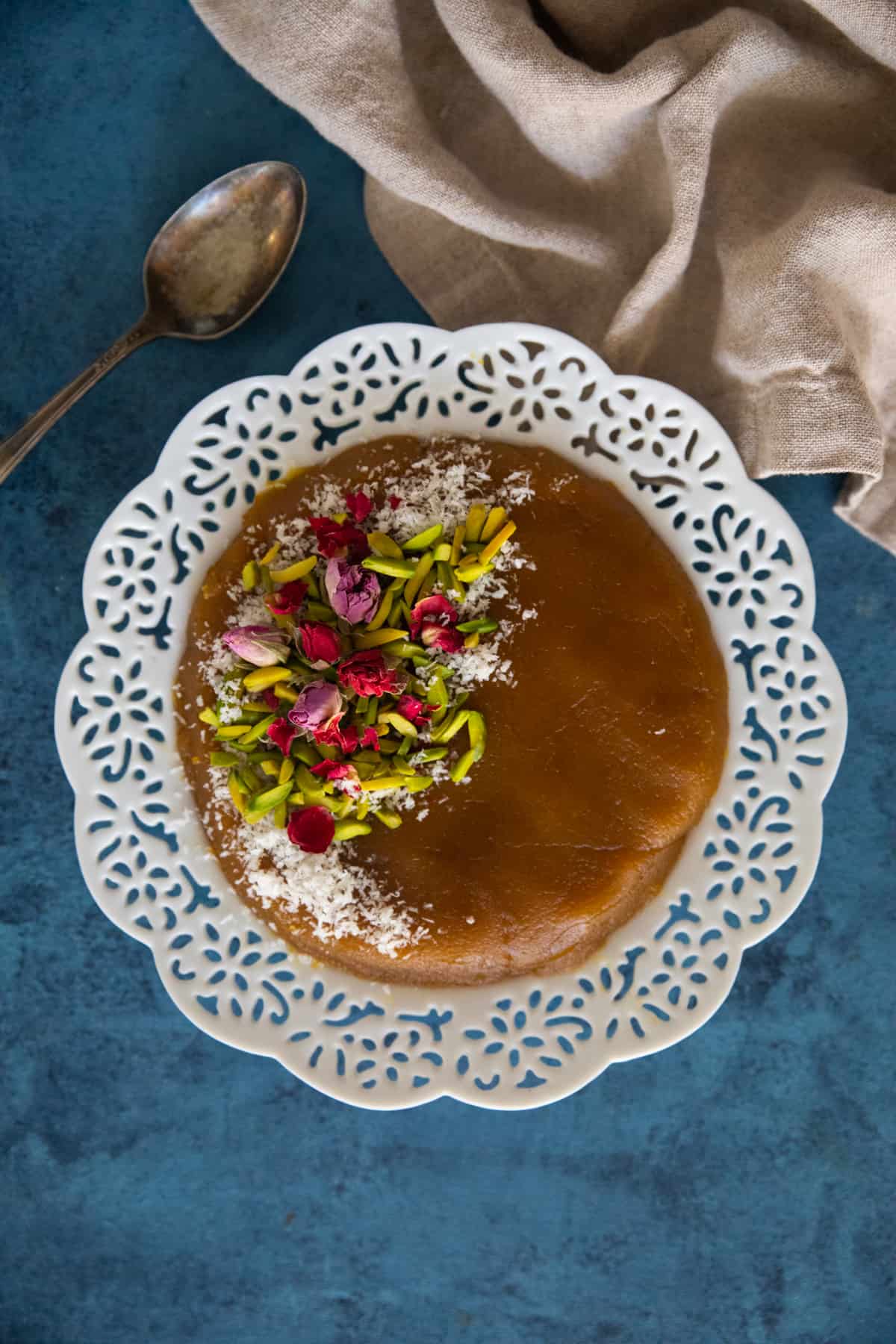
When it comes to sweets and desserts, Persian cuisine has a lot to offer. From saffron ice cream and Persian love cake to khagineh (Persian sweet crepes with date syrup), our desserts are packed with flavors of saffron, cardamom and rosewater. Today’s recipe is a classic Persian halva that’s sweet and so comforting. Follow along to learn how to make this enchantingly easy dessert.
Table of Contents
About Persian Halva
Halva is a sweet treat that’s popular across the Middle East and Mediterranean regions. There are many varieties of halva including tahini halva, semolina halva, and flour halva – which is the variation we are talking about today.
In Iran, halva is usually made with wheat flour, butter, oil and saffron syrup, giving it a smooth and velvety texture that’s thicker than kachi (halva pudding) with a medium to dark brown color. Similar to Turkish delight, Halva is sometimes flavored with rese water as well.
Iranians commonly serve Persian halva at funerals or during the month of Ramadan. Halva’s traditional association with funerals probably comes from its sweetness and texture – it’s simultaneously comforting and easy to swallow even if you’re sobbing.
These days you can find many styles of halva in Iran; the one I’m showing you here is a pretty simple and basic version that you can make quickly with just a handful of ingredients.
- Sugar: Granulated sugar would work best for this recipe and cannot be substituted with other sweeteners – I’d advise against trying to substitute brown sugar or stevia.
- Saffron: A little bit goes a long way. You need to bloom ground saffron to flavor the syrup.
- All purpose flour: This is the base of the halva. You need to toast the flour long enough to get rid of the raw smell and for the color to change to brown but not burnt. If desired, you can substitute half of the all purpose flour with whole wheat flour. It’s best to sift the flour prior to cooking.
- Oil: Use vegetable or canola oil for this recipe, olive oil will not work for halva.
- Butter: You need both butter and oil for halva to get that nice silky texture.
- Toppings: This can vary depending on your preferences. My favorite toppings are ground pistachios, slivered almonds, edible rose and desiccated coconut.
How To Make Persian Halva
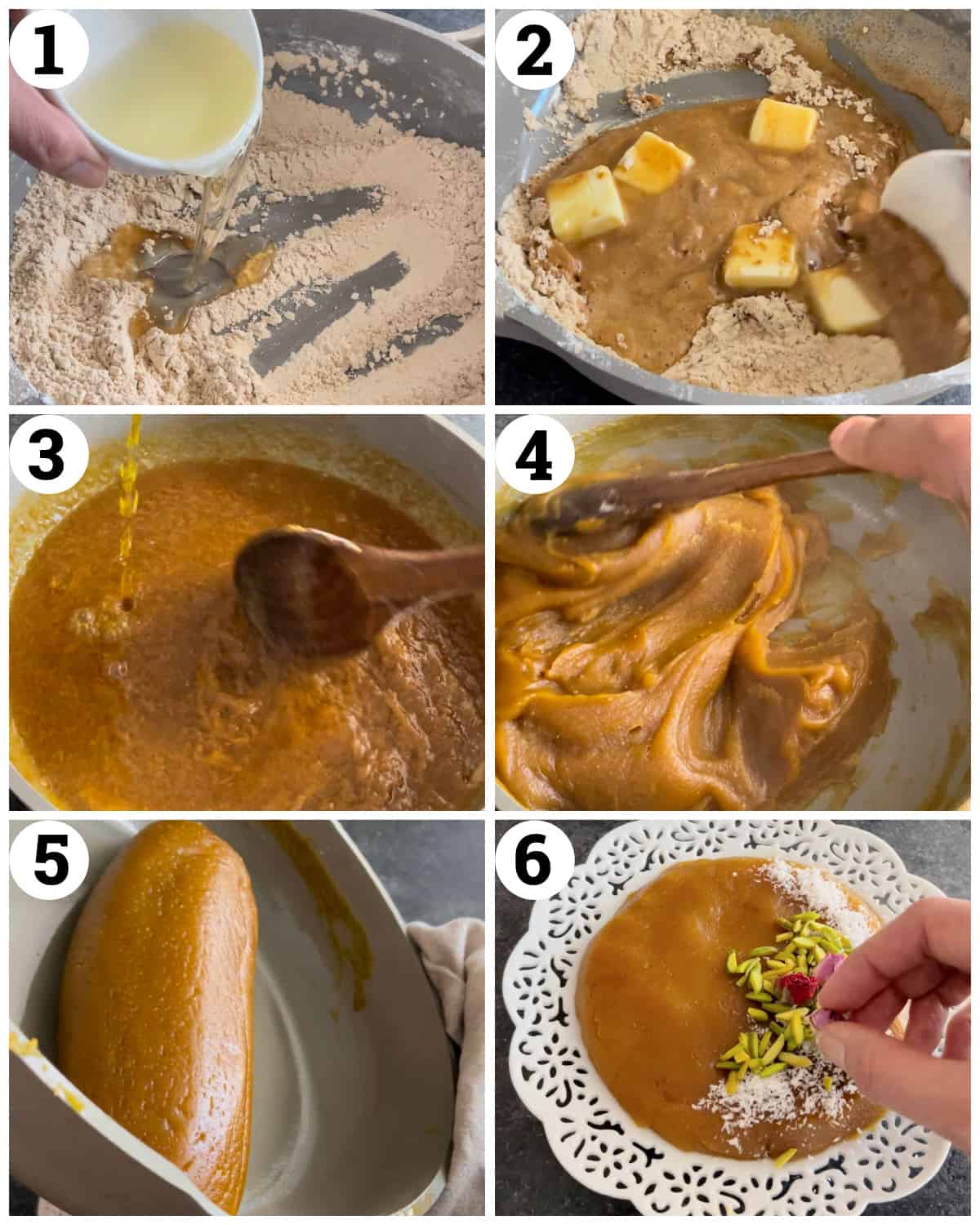
- Make the syrup: Place the sugar and water in a saucepan and bring it to a simmer. Cook for 15 minutes. Add in the bloomed saffron and rosewater and cook for 3 more minutes. Turn the heat off and set the syrup aside.
- Toast the flour: Heat a large pan over medium heat and toast the flour for 20 to 25 minutes until it smells nutty and the color is light to medium brown.
- Butter and oil: Add in the butter and oil to the toasted flour and cook for 15 more minutes. This will form a roux that’s smooth and has no lumps.
- Syrup: Slowly add the syrup and stir well using a wooden spoon until the halva comes together. The mixture will be sticky.
- Final mix: Set the spoon aside and start shaking the pan and tilting the halva from one side to the other until it separated from the pan and forms a roll.
- Plate and serve: Transfer to a plate and smoothen the top with an oiled spoon. Top with ground pistachios, desiccated coconut, edible rose and slivered almonds.
Serving Iranian Halva
As I mentioned above, halva is usually served in the month of Ramadan or at funerals with Persian tea. There are many ways to serve Persian halva, including on a plate as shown here or between wafer sheets so that it’s easy to pick up.
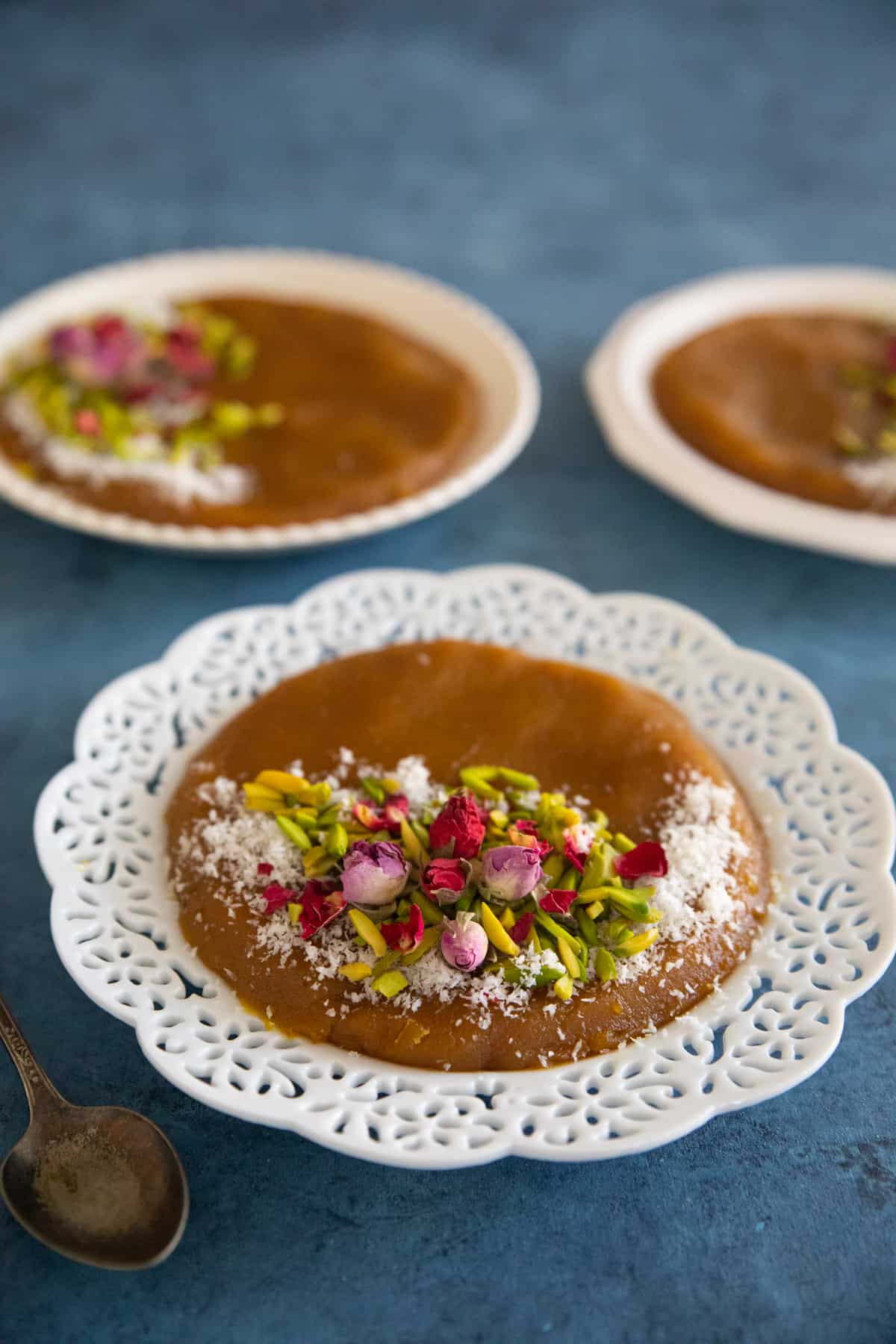
Storage
Store the leftovers in an airtight container and refrigerate for up to 4 days. Its’s best to let the halva come to room temperature before serving.
I don’t recommend freezing halva since the texture would change and the syrup might crystalize.
Frequently asked questions
Saffron adds a lot of flavor to this dish so I strongly recommend using it. However, if it’s not available, leave it out but keep the rosewater for flavor and aroma.
Yes, you can make halva up to 2 days in advance and keep it refrigerated. Let it come to room temperature before serving.
Semolina halva is very different from flour halva in flavor and texture. I’ll be publishing a semolina halva recipe in the near future!
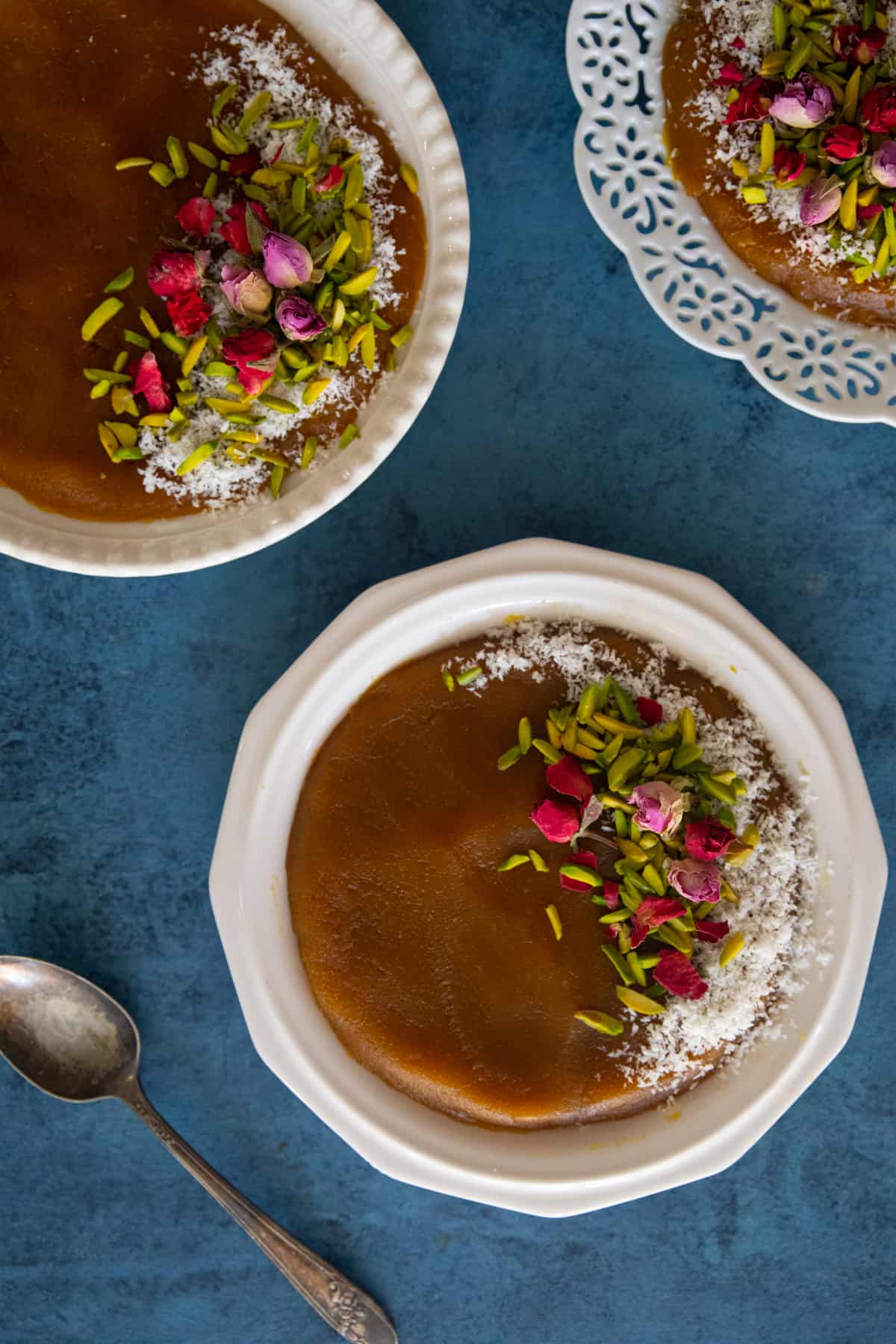
More Middle Eastern Desserts
Turkish Recipes
Revani Cake (Turkish Semolina Cake)
Dessert
Baklava
Persian Recipes
Walnut Filled Persian Pastry – Qottab
Dessert
Persian Love Cake Recipe
Did you make this recipe? I’d love to hear about it! Please comment and leave a 5-star🌟 rating below. You can also follow us on Instagram, Facebook, Pinterest or subscribe to our newsletter to get a free e-Cookbook!
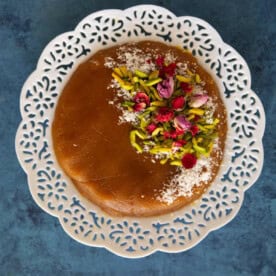
Persian Halva Recipe
Ingredients
- 1/4 tsp ground saffron
- 1 cup sugar
- 1 1/2 cup water
- 2 tbsp rosewater
- 1 cup all purpose flour
- 6 tbsp unsalted butter
- 1/3 cup vegetable oil
Toppings
- desiccated coconut
- edible rosebuds
- ground pistachios
- slivered almonds
Instructions
- Sprinkle the ground saffron on 2 cubes of ice and let it melt at room temperature. This will be your bloomed saffron.
- Place the sugar and water in a saucepan over medium high heat. Simmer for 15 minutes. Add in the saffron and rosewater, then simmer for 5 more minutes. Turn the heat off and set it aside.
- Place a large pan over medium heat and toast the flour for 20 to 25 minutes until it smells nutty and the color is light to medium brown.
- Add in the butter and oil to the toasted flour and cook for 15 more minutes. Make sure there are no lumps.
- Gradually add the syrup and mix well using a wooden spoon until the halva comes together. The mixture will be sticky. Set the spoon aside and start shaking the pan and tilting the halva from one side to the other until it separated from the pan and forms a roll.
- Transfer the halva to a plate and smoothen the top with the back of an oiled spoon. Top with ground pistachios, desiccated coconut, edible rose and slivered almonds.
Video
Notes
- Store the leftovers in an airtight container and refrigerate for up to 4 days. Let the halva come to room temperature before serving.
- Saffron adds a lot of flavor to this dish, however, if it’s not available, leave it out and use rosewater.
- Toasting the flour could take up to 30 minutes depending on the heat and the flour. Make sure not to turn the heat up so it won’t burn.
- You can use 1/2 cup all purpose flour and 1/2 cup whole wheat flour if preferred.
Nutrition
Nutrition information is automatically calculated, so should only be used as an approximation.
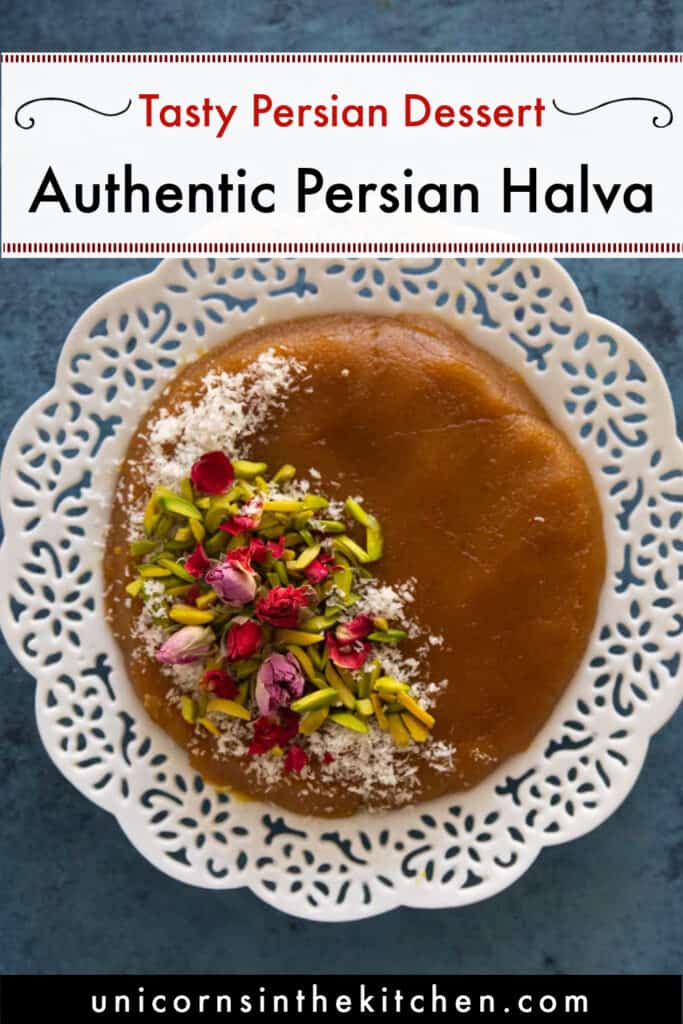
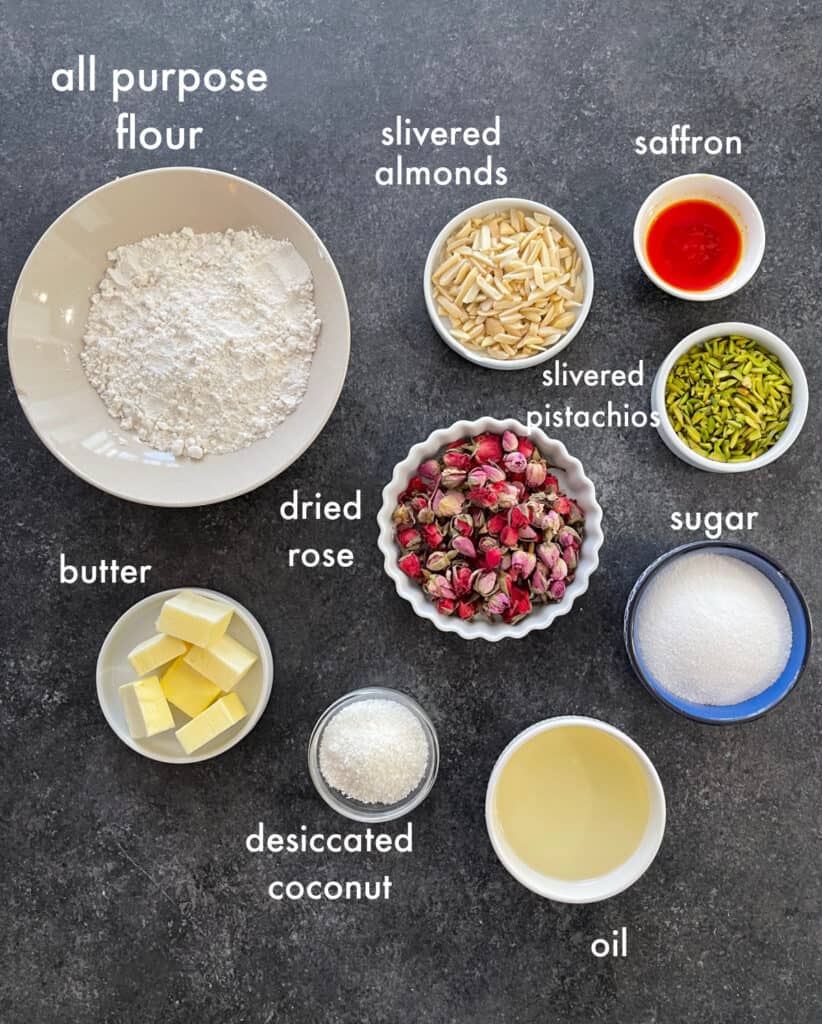

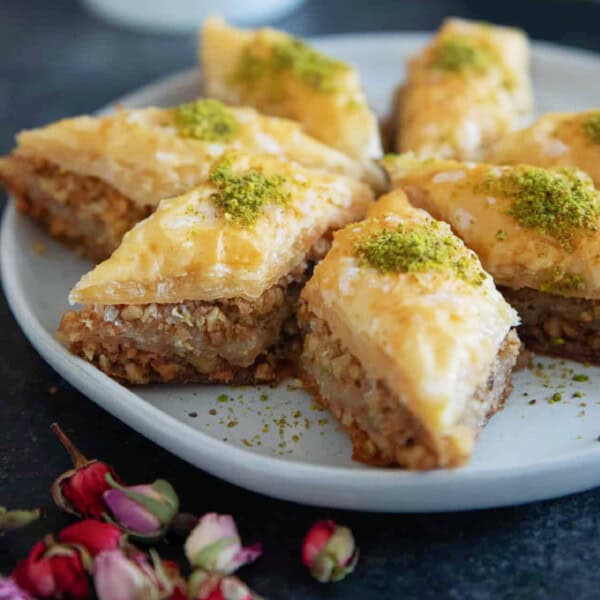

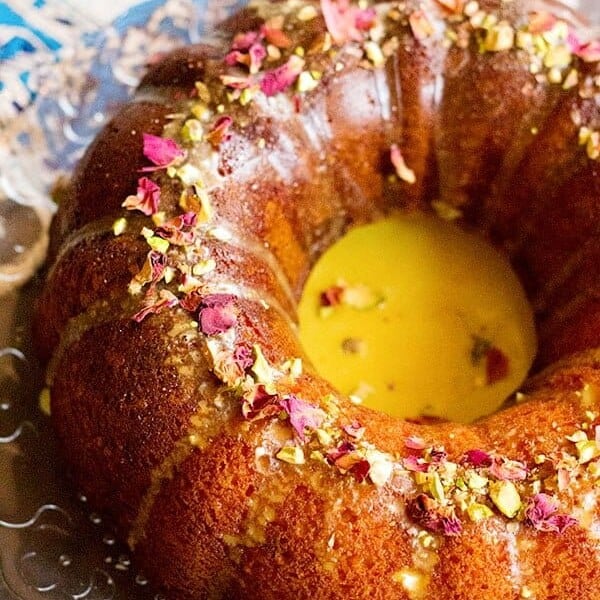









Hi Shadi, my husband who is from Iran has been hinting for sometime that he is missing halwa. Last night I thought I would suprise him , I followed your recipe to a tee and it was perfect ,he loved it !
Thanks for sharing your recipe x
Hi Abda! Thank you for your comment and I’m happy to know you guys enjoyed the halva!